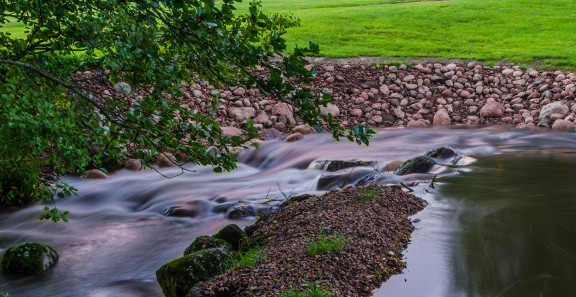Guidance for future designers
Sillanpää has been launching and developing research into the quality and quantity of stormwater at Finnish universities since the early 2000s. Since then, she has shifted her focus to experimental research and modeling stormwater management methods. “My research currently focuses on stormwater management, and we’re studying things such as the effectiveness of various filtration structures,” says Sillanpää.
The researchers are seeking cost-effective strategies for preventing problems relating to both stormwater quality and quantity. For example, plans for managing floods will not automatically affect the erosion of urban streams or the harmful material load caused by stormwater. “Research enables us to explore different options and bring best practices to planning.”
Another main theme in her research is the development of modeling tools for designers in the field. “We model things such as green infrastructure, the quality and quantity of stormwater, and how harmful substances are carried into waterways from urban areas,” says Sillanpää. Researchers are also exploring ways to improve the reliability of existing modeling practices and their adaptability to Finnish urban environments.
Climate change and urbanization are creating stricter requirements for stormwater management. The latest research results need to be utilized quickly in practical planning work.
Nora Sillanpää, Sitowise
In her position as Adjunct Professor, it is also Sillanpää’s task to act as an advisor for master’s theses and doctoral dissertations in Aalto University’s Department of the Built Environment. “Another goal is to strengthen teaching in urban hydrology in our Master’s program,” says Koivusalo.
Climate change and urbanization are creating stricter requirements for sustainable and natural stormwater management, which in turn places new demands on designers in the field. “For my part, I want to make sure that designers obtain the skills they need,” says Sillanpää.
Multidisciplinary interaction is part of urban water management
Every year, Aalto University’s Master’s Program in Water and Environmental Engineering results in about 25 new graduates and the doctoral program in a couple of doctors of technology. MSc. (Tech.) degrees have a firm practical foundation and external connections are valuable.
“Our activities rely on connections,” says Koivusalo. Collaboration with companies and stakeholders ensures that students can find both trainee positions and employment after graduation. Multidisciplinary cooperation is also vital in practical projects. “Cities are our clients, the university provides information, the consultants design solutions, and material and equipment suppliers put them into practice.”
Sillanpää is also fascinated by the diverse interaction that stormwater management requires. One of her goals is to promote cooperation and information flow between the various parties involved. “Universities also have a part to play in the social impact of research, which is why I think it’s important for new information to find its way out of the academic community. The latest research results must be utilized quickly in practical planning.”

